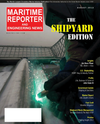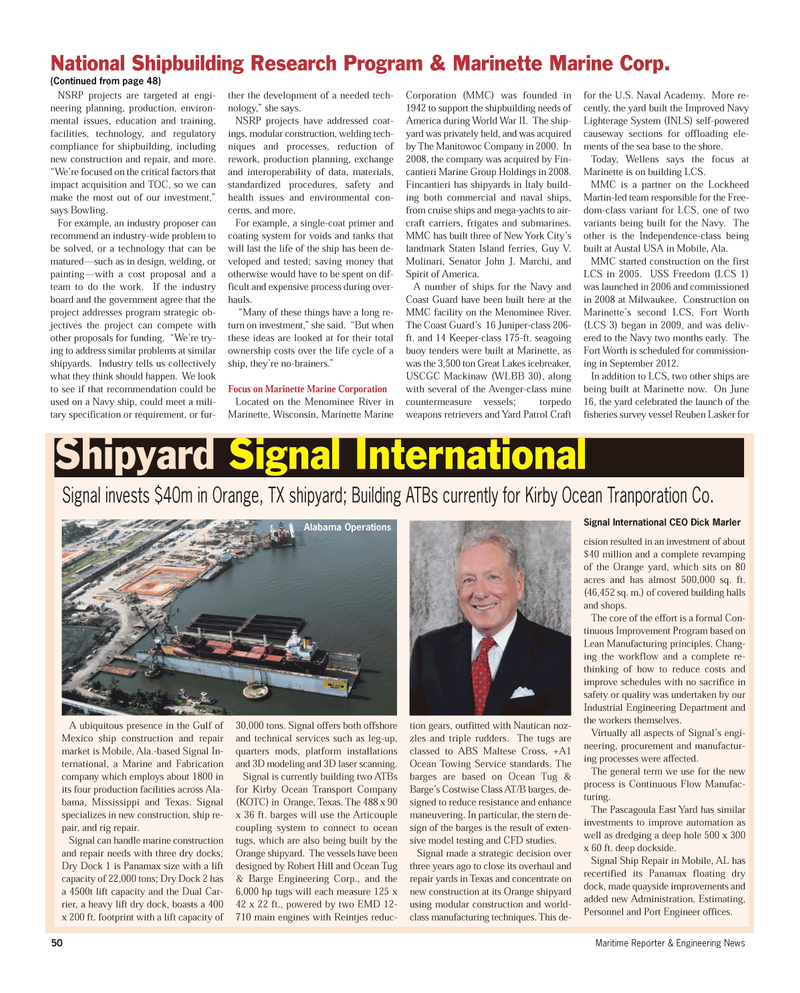
Page 50: of Maritime Reporter Magazine (August 2012)
The Shipyard Edition
Read this page in Pdf, Flash or Html5 edition of August 2012 Maritime Reporter Magazine
50Maritime Reporter & Engineering News NSRP projects are targeted at engi- neering planning, production, environ- mental issues, education and training,facilities, technology, and regulatory compliance for shipbuilding, including new construction and repair, and more. ?We?re focused on the critical factors that impact acquisition and TOC, so we can make the most out of our investment,? says Bowling. For example, an industry proposer can recommend an industry-wide problem tobe solved, or a technology that can be matured?such as in design, welding, orpainting?with a cost proposal and ateam to do the work. If the industry board and the government agree that the project addresses program strategic ob- jectives the project can compete with other proposals for funding. ?We?re try- ing to address similar problems at similarshipyards. Industry tells us collectively what they think should happen. We look to see if that recommendation could beused on a Navy ship, could meet a mili- tary specification or requirement, or fur- ther the development of a needed tech- nology,? she says. NSRP projects have addressed coat- ings, modular construction, welding tech-niques and processes, reduction ofrework, production planning, exchange and interoperability of data, materials,standardized procedures, safety andhealth issues and environmental con- cerns, and more. For example, a single-coat primer and coating system for voids and tanks that will last the life of the ship has been de-veloped and tested; saving money that otherwise would have to be spent on dif- ficult and expensive process during over- hauls.?Many of these things have a long re- turn on investment,? she said. ?But when these ideas are looked at for their total ownership costs over the life cycle of a ship, they?re no-brainers.? Focus on Marinette Marine Corporation Located on the Menominee River in Marinette, Wisconsin, Marinette Marine Corporation (MMC) was founded in 1942 to support the shipbuilding needs of America during World War II. The ship- yard was privately held, and was acquired by The Manitowoc Company in 2000. In 2008, the company was acquired by Fin- cantieri Marine Group Holdings in 2008.Fincantieri has shipyards in Italy build- ing both commercial and naval ships, from cruise ships and mega-yachts to air- craft carriers, frigates and submarines. MMC has built three of New York City?s landmark Staten Island ferries, Guy V. Molinari, Senator John J. Marchi, andSpirit of America. A number of ships for the Navy and Coast Guard have been built here at the MMC facility on the Menominee River. The Coast Guard?s 16 Juniper-class 206- ft. and 14 Keeper-class 175-ft. seagoing buoy tenders were built at Marinette, as was the 3,500 ton Great Lakes icebreaker, USCGC Mackinaw (WLBB 30), along with several of the Avenger-class mine countermeasure vessels; torpedo weapons retrievers and Yard Patrol Craft for the U.S. Naval Academy. More re- cently, the yard built the Improved Navy Lighterage System (INLS) self-powered causeway sections for offloading ele- ments of the sea base to the shore. Today, Wellens says the focus at Marinette is on building LCS. MMC is a partner on the LockheedMartin-led team responsible for the Free-dom-class variant for LCS, one of two variants being built for the Navy. The other is the Independence-class beingbuilt at Austal USA in Mobile, Ala. MMC started construction on the first LCS in 2005. USS Freedom (LCS 1)was launched in 2006 and commissioned in 2008 at Milwaukee. Construction on Marinette?s second LCS, Fort Worth (LCS 3) began in 2009, and was deliv- ered to the Navy two months early. The Fort Worth is scheduled for commission- ing in September 2012. In addition to LCS, two other ships are being built at Marinette now. On June 16, the yard celebrated the launch of thefisheries survey vessel Reuben Lasker for National Shipbuilding Research Program & Marinette Marine Corp. (Continued from page 48) Shipyard Signal InternationalA ubiquitous presence in the Gulf ofMexico ship construction and repair market is Mobile, Ala.-based Signal In- ternational, a Marine and Fabrication company which employs about 1800 in its four production facilities across Ala- bama, Mississippi and Texas. Signal specializes in new construction, ship re- pair, and rig repair. Signal can handle marine constructionand repair needs with three dry docks;Dry Dock 1 is Panamax size with a lift capacity of 22,000 tons; Dry Dock 2 hasa 4500t lift capacity and the Dual Car- rier, a heavy lift dry dock, boasts a 400 x 200 ft. footprint with a lift capacity of30,000 tons. Signal offers both offshore and technical services such as leg-up, quarters mods, platform installationsand 3D modeling and 3D laser scanning. Signal is currently building two ATBs for Kirby Ocean Transport Company (KOTC) in Orange, Texas. The 488 x 90 x 36 ft. barges will use the Articouple coupling system to connect to oceantugs, which are also being built by the Orange shipyard. The vessels have been designed by Robert Hill and Ocean Tug & Barge Engineering Corp., and the 6,000 hp tugs will each measure 125 x42 x 22 ft., powered by two EMD 12- 710 main engines with Reintjes reduc-tion gears, outfitted with Nautican noz- zles and triple rudders. The tugs are classed to ABS Maltese Cross, +A1 Ocean Towing Service standards. The barges are based on Ocean Tug & Barge?s Costwise Class AT/B barges, de- signed to reduce resistance and enhancemaneuvering. In particular, the stern de- sign of the barges is the result of exten- sive model testing and CFD studies. Signal made a strategic decision over three years ago to close its overhaul and repair yards in Texas and concentrate on new construction at its Orange shipyard using modular construction and world- class manufacturing techniques. This de- cision resulted in an investment of about $40 million and a complete revamping of the Orange yard, which sits on 80acres and has almost 500,000 sq. ft.(46,452 sq. m.) of covered building halls and shops.The core of the effort is a formal Con- tinuous Improvement Program based on Lean Manufacturing principles. Chang- ing the workflow and a complete re- thinking of how to reduce costs and improve schedules with no sacrifice in safety or quality was undertaken by our Industrial Engineering Department andthe workers themselves. Virtually all aspects of Signal?s engi- neering, procurement and manufactur- ing processes were affected. The general term we use for the new process is Continuous Flow Manufac- turing.The Pascagoula East Yard has similar investments to improve automation as well as dredging a deep hole 500 x 300x 60 ft. deep dockside. Signal Ship Repair in Mobile, AL has recertified its Panamax floating dry dock, made quayside improvements and added new Administration, Estimating, Personnel and Port Engineer offices. Signal invests $40m in Orange, TX shipyard; Building ATBs currently for Kirby Ocean Tranporation Co. Signal International CEO Dick MarlerAlabama OperationsMR#8 (50-57):MR Template 8/9/2012 9:59 AM Page 50

 49
49

 51
51
